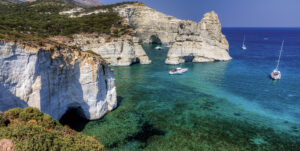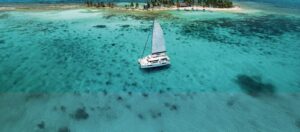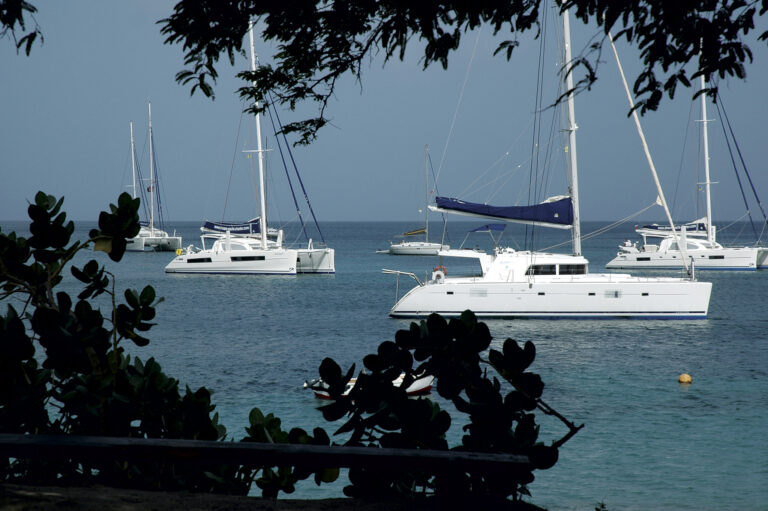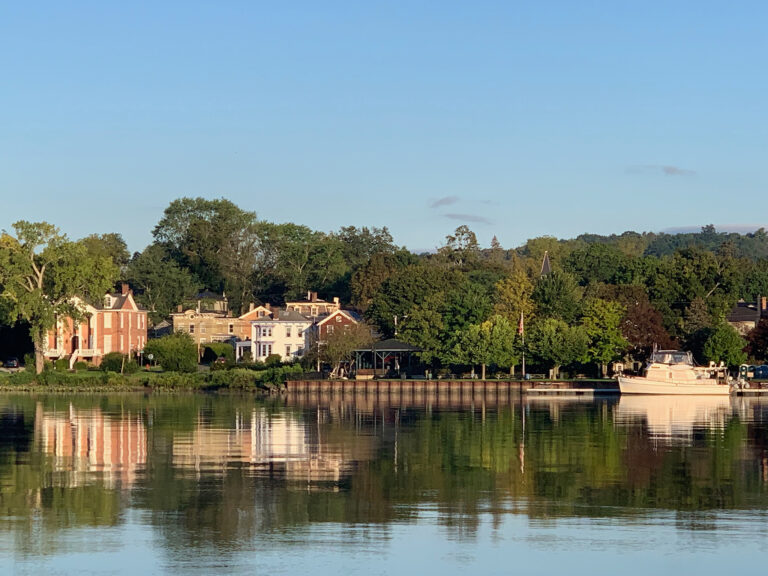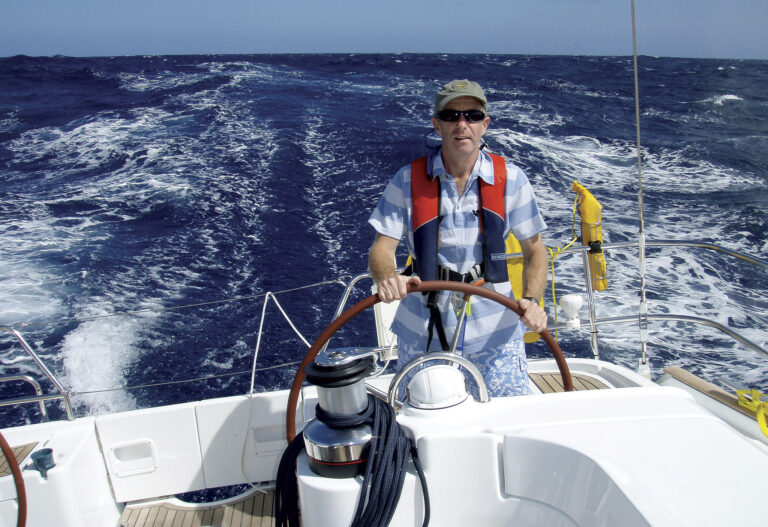In retrospect, I suppose my family and I have been lucky. In all the years we’ve gone bareboat chartering, we’ve never once been truly skunked by the weather. Friends tell harrowing tales of being shut down by raging Christmas winds in the Caribbean or of being half frozen by the end of a chilly spring week in the Bahamas, but not us. The closest we’ve ever come to meteorological disaster was when Hurricane Isaac threatened to cut things short during a trip to the Sea of Abaco—until it decided to go spinning off and harry the Republican National Convention in Tampa instead.
Alas, our luck seemed to run out on a recent Miami charter, when the wind blew a steady 10 to 20 knots out of the south-southwest for three full days as we were trying to work our way down to Key Largo—some 30 miles to the south-southwest. It then seemed to become truly malevolent as it switched to the north-northeast at the exact same time we needed to return to Miami Beach.
A funny thing happened, though, on the way to charter disaster—the Florida Keys, and the incredible wildlife and anchorages found there. It’s hard to believe when surrounded by the sprawl and kitsch that is Miami and much of Route 1, but you’re never far from some of the most secluded and pristine waters in North America. Do your island-hopping mid-week while the powerboat crowd is hard at work earning the money to buy all that fuel they love to burn, and you’re talking absolute heaven.
South Beach, Baby
It all started in that most unnatural of places, The Moorings’s new charter base in the middle of the Miami Beach Marina, a few blocks from South Beach. Stepping aboard our Leopard 39, Merry Seas, we found ourselves surrounded by high-rises, megayachts and the towering cranes of the Port of Miami—the most unusual place for a charter base I’ve seen.
That having been said, it would be hard to find a better or more practical chartering platform than the Leopard 39, a product of South Africa’s Robertson and Caine boatyard that is also available as the Moorings 3900. It would also be hard to find a better charter manager than Roger Simon, a veteran sailor originally from the Chicago area, with an impressive resume. His guidance was invaluable, as Biscayne Bay and the northern Keys, for all their natural beauty, can be a tricky place to sail.
Though the tidal range is only a couple of feet, the entire area is incredibly shallow, with shoals reaching out miles from shore to catch the unwary. Much of the eastern edge of Biscayne Bay, for example, appears wide open, with nothing but Soldier Key and the piling-mounted buildings of Stiltsville between you and the Atlantic. But don’t be fooled. There be dragons in these waters in the form of shoals waiting to rip out the keels of unsuspecting cruisers. Same thing to the south, where Featherbed Bank lurks with little more than four daymarks delineating a narrow dredged channel to show that it’s there.
Fortunately, the Intracoastal Waterway also bisects this particular body of water, which means navigational aids abound, and in this age of chartplotters, no one with even an iota of seamanship has any real excuse for hitting the bricks.
Roger also filled us in on Hawk Channel, a semi-open passage running from Biscayne National Park to Key West, between the Keys and a line of barrier reef that breaks the surface on occasion to the east. When the wind is right, this can still be one choppy body of water. Otherwise, it provides a relatively smooth and relatively deep avenue for those heading south.
Wangry (wang’grē), adj., 1. Feeling of anger or resentment toward persistent headwinds: Dad is wangry because the wind is on the nose again.
On the nose
Unfortunately, when it came time for us to start making our way to the Keys—the island chain that begins where Biscayne Bay ends—we immediately found ourselves bucking those aforementioned headwinds. Great stuff for the Star class Western Hemisphere Championships, which were taking place at the time, but for a 39ft cruising cat, not so much. We therefore decided to just sail around a bit to get used to the boat and then ducked into Dinner Key, where we grabbed a mooring and settled in for dinner afloat.
We took off first thing the next morning in the hopes of clicking off a few miles before the sea breeze amped up the already steady breeze on the nose—which worked, but still made for a heapin’ helpin’ of motoring, even as we tried rolling out the jib to help us along as the true wind veered a touch to the west. On the plus side, the sun was shining, the water was a magnificent aqua color, and we were now entering Biscayne National Park, an area abounding with marine life. That afternoon we tucked in behind Sands Key in all of 6ft of water and dinghied over the weedy shoal marking the southern boundary of shallow Lewis Cut to Boca Chita Key, where we did a little swimming and snorkeling.
Once the private property of electronics pioneer Mark Honeywell, Boca Chita is now run by the park service and features a compact harbor, picnic tables and a sweet little beach with mangroves on either end, all watched over by a nonfunctioning lighthouse. By the time we arrived late on Sunday things were pretty quiet, with only a half-dozen powerboats still tied up in the harbor.
It was the same thing with Elliott Key, a narrow strip of scrubby land stretching south-southeast of Sands.
Approaching from the west, we’d seen so many powerboats anchored off Elliott Key Harbor and the small stretch of beach north of Coon Point that we thought it was a pair of small villages, but now things appeared to be emptying out fast. Another reason we’d tarried at Dinner Key was to avoid what Roger had warned us it could be a pretty crazy scene there on a Saturday night, and we were glad we did. As it was, we had the shallow waters of the Sands Key anchorage pretty much to ourselves. Our only neighbor was a small monohull a quarter-mile away. There’s nothing like a swim in the clear waters of the Keys to wash away the frustration of a day of bucking a headwind.
Unfortunately, it was much the same as we traveled the rest of the way down Biscayne Bay to the long narrow channel in the Cutter Bank to Card Sound and the anchorage between Pumpkin Key and the northern tip of Key Largo. Worse yet, in contrast to Sands Key, there was no place to go ashore. Pumpkin Key is privately owned, and has more “No Trespassing” signs than CIA headquarters in Langley, Virginia.
As for Key Largo itself, the northern tip of the island is dominated by the exclusive Key Largo Anglers Club and the even more exclusive Ocean Reef Club—a community of large private homes and docks serviced by their own exclusive airstrip, with their own “Private—Keep Out” signs.
At this point the crew of the good ship Merry Seas wasn’t just wangry, it was also getting more than a little stir crazy at the idea of not being able to escape the boat and go hiking or visit some kind of beach.
However, there are few things more ridiculous than allowing yourself to be miserable on a charter, so we promptly made lemonade out of the lemons we’d been handed by leaping over the side and going for a swim. Next thing we knew, we were out rowing around in the dinghy checking out the local dolphin population, one of whom surfaced a mere 20ft in front of us. Afterward, we grilled some steak and potatoes off the stern for dinner and watched a gorgeous sunset up on the bow. Not bad!
Key Largo Sound
The next day brought more headwinds, but we were getting into our groove now. Better still, we were almost to the southernmost point on our itinerary, after which these persistent southerlies would, of course, become fair. We were also blessed with magnificent scenery in narrow, mangrove-lined Angelfish Creek, our passage to the Atlantic, and Hawk Channel, with its aquamarine waters and coral heads a mere fathom or two beneath the surface off in the distance.
Equally spectacular was our destination, Key Largo Sound, a two-mile-long lagoon with a dozen or so park service mooring balls in its southwest corner. It is accessed via a twisting, turning maze of small mangrove islets that has to be seen to be believed. Thank goodness we didn’t come across any sizeable tour boats on our way in, because it would have been a tight squeeze, and I honestly don’t know if yours truly would have been up for it.
Within a half hour of securing Merry Seas with all of a foot and a half of water under our keels, we were ashore, splashing around on a small beach. We also booked a seat aboard one of the dive boats that regularly shuttle snorkelers out to the spectacular reefs in nearby John Pennekamp Coral Reef State Park.
One of my favorite things about chartering is the fact that it allows us to expose our 11-year-old daughter, Bridget, to things she would never experience on land. The snorkeling on Grecian Rocks, about four miles offshore, was nothing less than spectacular—the kind of thing I never had a chance to experience as a kid—and the kind of experience I’m happy to be able to provide mine.
Later, we took the dinghy over to a place called Sundowners on the other side of Key Largo overlooking Blackwater Sound, with Bridget at the helm the entire time. Not only was Sundowners the perfect place for a Keys dinner—think eating at the dock watching the tarpon hitting their dinner maybe 15ft away from where you’re hitting yours—but the route there, through the Marvin D. Adams Waterway, locally known as “the Cut,” directly under Route 1, was one of the best dinghy rides I’ve ever taken.
As far as I’m concerned you can keep your high-rises and exclusive mansions: the funky little homes ringing Key Largo Sound and the Cut are living. As for Blackwater Sound, it was absolutely placid in the still, slightly hazy evening air in a way that reminded me of the dead calm at the opening of Joseph Conrad’s novella The Secret Sharer.
If I’d had any doubts whether cruising the Keys was for me, those doubts were long past. Key Largo is one of those places where once you get there, a part of you never wants to leave—the mark of a truly great cruising destination.
Wangrier and Wangrier…
Then it happened: we woke the next morning, looking forward to a well-deserved broad reach back toward Biscayne Bay only to discover that the wind had swung round into the northeast.
Seriously? Even Bridget was getting a little pissed off now.
Worse yet, when I double-checked the tides, I discovered the first mate on the dive boat had given us the wrong time for slack water. Normally, this might not have been a big deal, but when an entire two-mile-long body of water fills and empties through a handful of narrow channels, you need to take the currents seriously. On our way out to Grecian Rocks the previous day I’d noticed the current was truly ripping, and when I asked that same first mate about it, he said, yes, it could hit 4 knots or more—no big deal for a generously powered motorboat, but for a charter cat like Merry Seas, well …
Fortunately, my family is much better tempered than me. Within an hour of casting off our mooring we were beating into a northerly that had gone just east enough to make it worth our while to turn off our auxiliaries—barely. It didn’t make any kind of sense in terms of VMG, but it sure was fun, especially on port tack when we reached the eastern edge of the channel and found ourselves in a couple of fathoms of water watching the sea fans waving up at us from below.
Even better was our anchorage that night, a wide-open roadstead to the west of the long strip of brush and mangroves that is Elliott Key, which guards the southeast corner of Biscayne Bay. Making our final approach via the Cutter Bank channel I confess I got a bit wangry again—I mean, seriously, not 48 hours earlier we’d been going the opposite direction with the wind right on the nose at almost the same angle and speed. But then we arrived just off Coon Point, where we set the hook in a sandy bottom in a fathom of crystal-clear water, and any and all wangry thoughts disappeared in an instant.
In contrast to the weekend, the waters off Elliott Key were now empty, save for another catamaran about a quarter-mile closer to shore and a small monohull a half mile north of us. Looking over the side we could see the sand and sea grass as clearly as if we were looking down into an oversized aquarium. Snorkeling off the small strip of sand ashore we found an abundance of sea life, including a puffer fish, a couple of small barracuda and even a tiny black seahorse—a first for the crew of the Merry Seas. Later we found a 3ft remora that seemed to think Merry Seas was some kind of a shark or whale and a highly stressed spiny lobster that had sheltered under a rock directly beneath our port rudder. I shudder to think what was going through the poor creature’s mind as we were doing cannonballs off Merry Seas’s side decks.
Best of all, when we awoke the next morning we found our bows were pointed directly into … the south-southwest! Granted, the wind wasn’t especially strong, but it was fair and we weren’t in that much of a hurry to get back to the Miami Beach Marina anyway. After days of struggling to get someplace there was suddenly no place in the world we’d rather be that just mozying along the gentle tepid waters off South Florida. Now if only we hadn’t just finished off the last of our coffee…
FACT FILE
We chartered our Leopard 39 from The Moorings (moorings.com) in Miami. Dream Yacht Charters (dreamyachtcharter.com) also has a base in nearby Ft. Lauderdale. For a list of other companies operating in the area, go to sailmagazine.com.
You can fly direct to Miami from almost any major airport in the United States. South Florida makes for a great destination year-round. However, be warned: things get pretty sticky when the wind goes light in the summer. Bugs can also be a trial on shore in the summer months, so be prepared to anchor out.
October 2015



